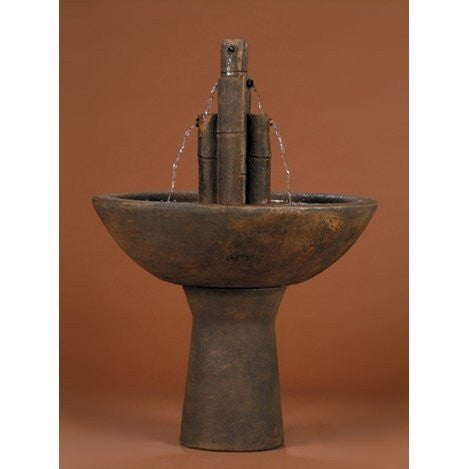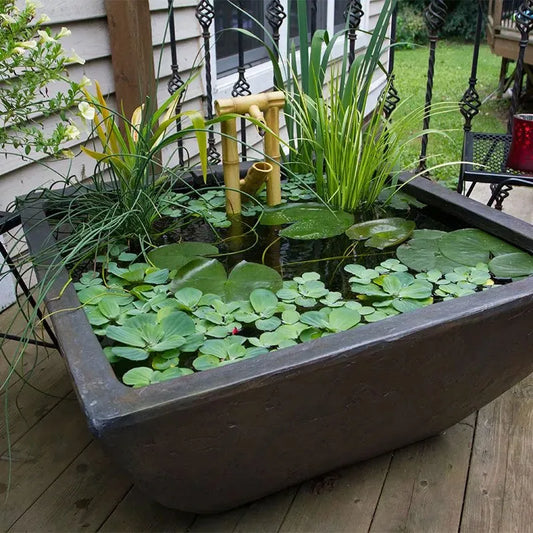Collection: Japanese Style Fountains
Invite tranquility into your world with genuine Japanese style fountains. Crafted from nature's elements and minimalist forms, these water features cultivate serene atmospheres, ideal for enriching both interior and exterior settings.
-
30" Copper Creeping Japanese Maple Tree Garden Fountain
Regular price $8,799.99 USDRegular priceUnit price / per -
38" Copper Japanese Maple Tree Garden Fountain
Regular price $7,777.77 USDRegular priceUnit price / per -
Bamboo Cast Stone Garden Fountain
Regular price $1,778.75 USDRegular priceUnit price / per -
Pagoda Fountain
Regular price $1,638.75 USDRegular priceUnit price / per -
Textured Gray Slate Patio Ponds
Regular price From $499.98 USDRegular priceUnit price / per -
Triple Drilled Yasuyuki Stone Fountain
Regular price $4,666.66 USDRegular priceUnit price / per$5,100.00 USDSale price $4,666.66 USDSale
Cultivate Serenity with Japanese Style Fountains
More than mere adornments, Japanese style fountains embody a deep cultural respect for nature's balance. Our collection presents designs true to traditional artistry, built with lasting quality. Every fountain can become a focal point, creating a tranquil haven in your garden or on your patio.
Qualities of Japanese Style Fountains
- Meditative Atmosphere: Fosters calm settings that soothe the mind and encourage reflection.
- Cultural Integrity: Features authentic design aspects rooted in Japanese garden heritage.
- Harmonious Placement: Balances water, stone, and flora, often aligning with principles of spatial arrangement.
- Unique Soundscapes: Generates distinct water sounds, from soft murmurs to the characteristic bamboo 'clack'.
- Artistic Presence: Functions as dynamic sculptures where utility meets refined beauty.
- Timeless Charm: Complements outdoor areas throughout the year with enduring designs.
Distinctive Japanese Fountain Styles
Shishi-Odoshi (Deer Scarer) Fountains: These iconic bamboo fountains feature pivoting spouts that fill with water before tipping to create a distinctive "clack" sound. Originally intended to startle wildlife from crops, these rhythmic fountains are now meditative features in modern gardens, blending visual movement with calming auditory patterns.
Tsukubai Stone Basin Fountains: Traditionally found at tea house entrances, these low stone basin fountains signify purification and humility. Our tsukubai selections showcase authentic stonework with gentle water flow, producing subtle ripples while honoring age-old ceremonial traditions.
Suikinkutsu Hidden Water Bell Fountains: These refined underground water chime fountains produce ethereal, echoing sounds as water droplets fall into buried vessels. These understated fountains create musical tones that seem to arise mysteriously from the earth, reflecting the Japanese appreciation for subtlety.
Bamboo Spout (Kakei) Fountains: Using natural or faux bamboo conduits, these fountains guide gentle streams into stone basins or ponds. The simplicity of bamboo underscores the Japanese design ethos of using natural materials in minimally altered forms to achieve beauty. These spouts can be standalone features or integrated into larger water systems, including some styles of pond fountains where a subtle Japanese touch is desired.
Contemporary Japanese-Inspired Fountains: Modern adaptations that uphold core Japanese aesthetic values while using updated materials and technology. These designs provide easier upkeep while retaining the essential tranquility and balance of classic forms.
Stone Lantern Fountains: Merging traditional Japanese stone lantern (tōrō) forms with gentle water elements. These substantial pieces act as garden anchors, combining potential illumination with the reflective qualities of moving water.
Selecting Your Perfect Japanese Style Fountain
When choosing a Japanese style fountain, weigh both functional needs and aesthetic desires. For compact areas like patios or indoors, smaller bamboo fountains or tabletop stone arrangements offer authentic character without dominating the setting. Larger landscapes can accommodate more substantial tsukubai basins or multi-element designs, creating immersive, zen-like retreats. These can be standalone masterpieces or part of a broader collection of outdoor fountains.
Material choice greatly affects both look and durability. Classic materials such as natural stone, bamboo, and ceramic provide genuine aesthetics but might need more care. Modern options using weather-resistant composites, treated bamboo, or specialized concrete give similar visual appeal with improved resilience for varied climates.
Consider the fountain's sound when deciding. Japanese garden philosophy values auditory aspects, with different designs making unique sounds. Shishi-odoshi produce rhythmic bamboo clacks with water sounds; tsukubai basins offer soft, steady trickling. Suikinkutsu create ethereal echoes. Each offers a distinct sensory experience. Whether you're creating a dedicated Zen space or adding a touch of Japanese artistry to existing garden fountains, the right choice makes all the difference.
Welcome the quiet strength of Japanese style fountains to your environment. These thoughtfully crafted water features go beyond simple decoration to become sources of calm and balance. Whether you desire an authentic garden centerpiece or a discreet desktop fountain, our Japanese-inspired collection provides the ideal element for your own haven of serenity and thought. For those with larger water features or ponds that might benefit from aeration to maintain clarity and health, exploring options from specialists like Scott Aerator can complement your overall water garden design.
Frequently Asked Questions
What maintenance do Japanese style fountains require?
Japanese style fountains generally need regular cleaning to prevent algae and mineral buildup, especially on stone. Bamboo parts should be checked for wear. Most benefit from quarterly deep cleaning and yearly checks of pumps and water systems. Natural bamboo might need occasional oiling or replacement based on climate; stone usually just needs cleaning.
Can Japanese fountains be used indoors?
Yes, many Japanese fountain types are well-suited for indoors, especially compact bamboo designs, small stone basins, and tabletop models. Indoor Japanese fountains foster peaceful settings in homes, offices, or meditation areas. For indoor use, pick self-contained units with good splash control and mind your room's humidity. Most operate with standard outlets and need little water refilling.
What makes a fountain authentically Japanese in style?
Authentic Japanese style fountains reflect principles like asymmetrical balance, minimalist looks, natural materials, and harmony with their setting. True Japanese designs value negative space, use natural elements with minimal alteration, and favor subtle sounds over bold water displays. Traditional parts like bamboo spouts, weathered stone, and simple basins echo centuries-old garden traditions focused on contemplation, not showiness.
How much space do I need for a Japanese fountain?
Space needs differ greatly. Tabletop models can use as little as one square foot, fitting apartments or offices. Medium sizes often need 3-5 square feet, good for patios or garden corners. Larger traditional setups with multiple elements (basins, spouts, landscaping) might need 25-100 square feet for authentic spacing and viewing.
What's the symbolism behind Japanese fountains?
Japanese fountains hold deep symbolic meanings from Shinto and Buddhist traditions. Water stands for purification and life's flow; stone for permanence. Tsukubai basins specifically represent humility, as one bows to use them. Bamboo signifies strength with flexibility; its hollow center, openness to wisdom. The balanced arrangement of parts reflects "ma" (negative space), inviting thought on the connections between visible items.
Are Japanese fountains difficult to install?
Installation difficulty varies. Self-contained Japanese fountains need little setup: position, fill, plug in. More complex ones might involve drainage, stable foundations for stone, and connecting bamboo pipes. Traditional designs often gain from professional installation for authentic proportions. Most makers give detailed instructions; many modern designs are made for easy DIY setup.






